How to deal with carrot fly and its larvae: methods of prevention, means for processing (watering)
You always want carrots to grow even, beautiful and, most importantly, with excellent taste. But often harmful insects appear on carrot beds, which cause significant damage to your crop. So, one of the most dangerous pests (along with the carrot leaf beet) of carrots is the carrot fly.
Next, let's talk in more detail about what kind of pest it is, what it looks like, what are the signs of damage to carrots, and also how to process the plantings in order to get rid of the carrot fly.
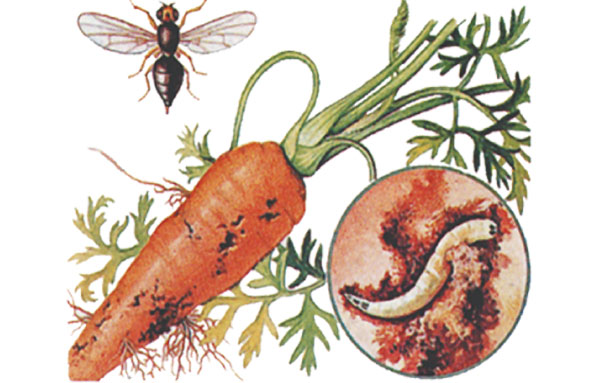
Content
- 1 What does a carrot fly look like and what is dangerous?
- 2 How to determine that a carrot fly has started up in the garden: signs of a pest
- 3 Ways to deal with carrot fly on the site
- 4 How to protect carrots from carrot flies: preventive or agronomic control measures
- 5 How to deal with a carrot fly or how to treat carrot beds: the best remedies (insecticides)
What does a carrot fly look like and what is dangerous?
Before you start fighting any garden or vegetable pest, you need to recognize the enemy by sight. This is necessary in order to notice the insect in time and take action quickly.
Carrot fly - small insect, only about 4-5 mm in length. It has a shiny cover of black color with a greenish tinge, the head is rounded, brown (rusty yellow), covered with bristles, the wings are shiny, thin and wide, the legs are yellowish.
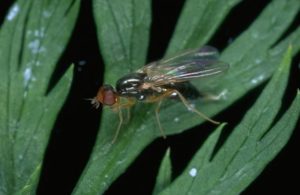
The insect lays small, milky white, oval (tapering towards the ends) eggs, 0.6-0.8 mm long.
Hatched from an egg larvae reach a length of 5-8 mm. Their cover is shiny, yellowish. They are somewhat similar to worms, but without a head. The front of the body is slightly pointed, the back has a rounded appearance, and black stigmas are visible at the end.
By the way! It is the carrot fly larvae that harm the carrots. In other words, the fly itself is an indirect pest, the main one being its larvae.
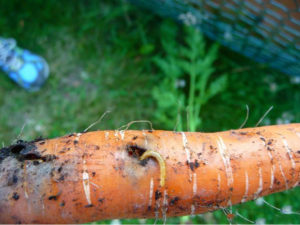
The life cycle of the carrot fly is relatively long.
Spring departure insects fall in the second decade or half of May, when the apple tree and chokeberry begin to bloom (in some regions this time is the same with lilac and cherry blossoms) and the soil warms up to + 15-18 degrees.
Prior to this, the carrot fly hibernates in the surface layer of the soil.
It is noteworthy that the carrot fly prefers wet, shaded areas (in other words, the pest is shade and moisture-loving), where it feeds on the nectar of flowers on umbrella or wild-growing celery plants (kupyra, sleepy).
From the second decade of May to mid-June, on cool days, in the mornings or evenings, the fly begins laying eggs in moist soil next to the roots (young shoots) of carrots.
From about the second half of June, the hatched larvae (i.e. 4-17 days after laying the eggs, depending on the weather) immediately find themselves close to the root crops, in which they settle, gnawing winding passages in them, and then filling them with the products of their vital activity.
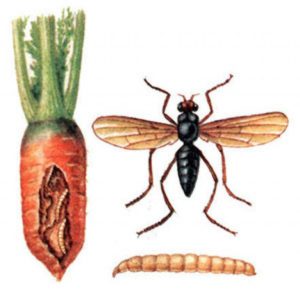
After 3-4 weeks, the larvae leave the roots and turn into pupae (pupate in the surface layer of soil at a depth of up to 10 cm), and after another 2-4 weeks flies of the second generation appear from the pupae. Thus, the cycle repeats itself. As a result, 2 generations of carrot flies develop in 1 year.
Important! Larvae of the second generation begin their activity in August, damaging larger roots.
Thus, the carrot fly is a very dangerous pest of carrots, the larvae of which can cause serious damage to your crop.
By the way! In addition to carrots, carrot fly (or rather its larvae) also damages the roots of parsnips, parsley and celery, in short, plant family umbrella.
How to determine that a carrot fly has started up in the garden: signs of a pest
Distinctive sign struck carrot fly root vegetable is the acquisition of a characteristic unnatural color by carrot leaves : they become purple-reddish (bronze) shade.
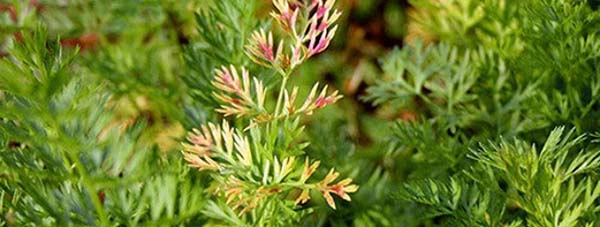
Further, as the root crop decays in the ground, the leaves turn yellow and dry out.
Eventually root vegetables lose their taste (become tasteless, or bitter and woody) may deform and naturally become unfit for storage.
If you pull out a root vegetable affected by a carrot fly larva, you will notice that it has enough ugly look (black constrictions, depressions, cracks) and bad smell... These are clear signs of damage to carrots by a carrot fly, or rather by its larva.
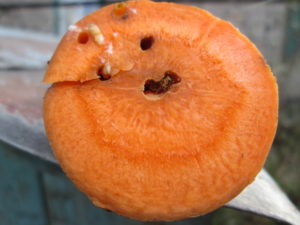
Interesting! Carrot fly damage is often confused with harmful activity wireworm.
Video: what is the danger of a carrot fly when it starts its activity, what are the signs and consequences of the activity of this pest
Ways to deal with carrot fly on the site
Conventionally, methods of dealing with carrot fly can be divided into:
- protective or preventive (agrotechnical, consisting in proper planting and care), which should help prevent the appearance of carrot flies in the carrot bed;
- directly methods of destructionthat will allow you get rid of the carrot fly completely (i.e. treatment of plantings with chemical and biological agents).
There are also deterrent ways of dealing with carrot fly, which are often called folk remedies.
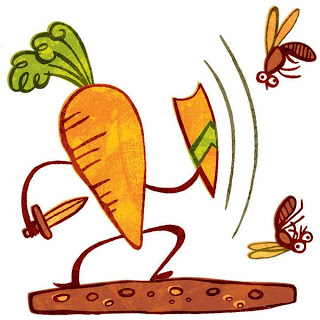
How to protect carrots from carrot flies: preventive or agronomic control measures
So, so that in the future you do not need to treat your beds with insecticides or special decoctions of herbs from carrot flour, you need to initially plant and care for your carrots correctly.
The main preventive measures of an agronomic nature that will allow you to avoid attacks by carrot flies include the following protection measures:
- For sowing carrots, you should choose exclusively sunny areas.
It is even better if the place is on a hill, well blown by the wind, without stagnant melt or rain water.
-
Do withenclosed landings. Plant carrots next to onions or garlic, or even better with calendula or marigolds (namely, alternate them in rows on the same bed or plant around the perimeter). The smell of these odorous plants will interrupt the carrot smell with its aroma and disorient pests.
So, according to the idea, the onion should act as a carrot fly repeller, and the carrot itself should act as an onion fly.
However! The advice is certainly popular, but this is more a myth than a really effective remedy.
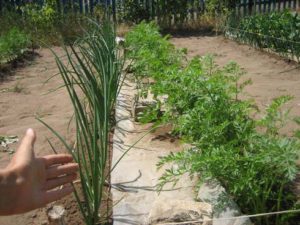
- Sow carrots as early as possible in the spring (or do winter sowing).
Advice! Alternatively, you can sow carrots in the fall before winter... Thanks to such a planting, in the spring the plants will be able to start growing faster and get stronger enough for the period of activity of the carrot fly: their small roots will become denser and will be too tough for the larvae.
- And preferably in advance treat seeds with insecticides.
For example, you can plant seeds by mixing them with tobacco dust, and first spill the grooves with birch tar.
- Crops can be immediately cover with a thin non-woven fabric (the same nylon mesh), and also better stretch the non-woven fabric over low arcs and grow carrots in such a greenhouse.
It is necessary to cover from the moment of sowing until the end of June (the first generation of the carrot fly), as well as from August until the moment of harvesting (the second generation) or all summer.
- Avoid thickening landings: either sow seeds at a sufficient distance initially, or be sure to thin out.
By the way! The site has a detailed article about how to plant carrots correctly, and thin out.
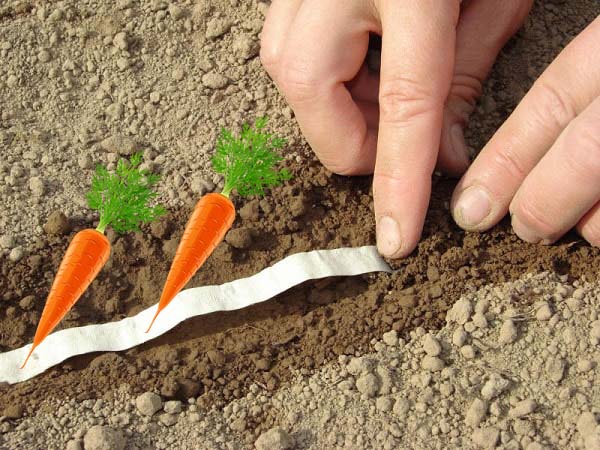
- Mulch the aisles (hay, straw, i.e. mown grass, rotted sawdust, coniferous litter, peat).
A sufficiently dense mulch will prevent the fly from laying eggs in the soil next to the seedlings.
- If you do not mulch plantings, then you need to regularly carry out weeding.
- Necessarily needed water properly (in no case fill), i.e. follow watering rates for carrots.
Excessive watering of carrots and, as a result, high humidity in the beds is one of the most common causes of pest infestations.
- By no means initially do not apply or fertilize carrots with fresh manure (including its infusion), the smell of which attracts flies very much.
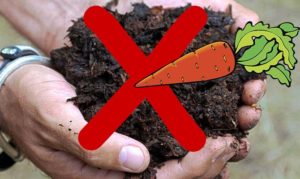
- Perform deep autumn soil digging.
Video: prevention of the appearance of a carrot fly or proper care for carrots in the open field
How to deal with a carrot fly or how to treat carrot beds: the best remedies (insecticides)
If the carrot fly is still started, or you prefer to use only products that definitely work, then this paragraph will be most useful to you.
So, the basic rules for using insecticides against carrot flies:
- The solutions should be prepared only according to the instructions on the packages, following the dosage recommendations (no less and no more).
- It is also necessary to use solutions only according to the instructions.
It should be processed either early in the morning, before the first rays of the sun appear, or late in the evening, after sunset.
- Be sure to pay attention to the waiting time after processing (after what time you can eat root vegetables).
- As a rule, the first treatment is carried out at the first appearance of the pest, and the repeated application is carried out with an interval of 7-10 days (most often 1-2 treatments are sufficient).
When to treat carrot fly beds
If the beds are sprayed from the carrot flies at the initial stages of plant development (after germination and when the cotyledons appear), then the treatment from the carrot fly is carried out at the stage of 1-4 true leaves (i.e. in the second half of May-early June).
It's simple - spraying is carried out precisely during the period of pest activity.
Chemicals (insecticides)
Naturally, the most effective way to control carrot flies is to use chemical insecticides.
So, the most popular means for the protection and fight against carrot flies are (in parentheses, the active ingredients, the method of entry and the chemical class are given):
- Actellic (Pirimifos-methyl (Actellic), non-systemic organophosphate insectoacaricide of intestinal action);
- Arrivo (Cypermethrin, an intestinal pyrethroid insecticide for protection against a wide range of gnawing and sucking pests);
- Boreas (Imidacloprid, Lambda-cyhalothrin, contact-intestinal systemic insecticide, pyrethroid and neonicotinoid class, to protect against a wide range of gnawing and sucking pests);
- Vantex (Gamma-cyhalothrin, an enteric pyrethroid insecticide for protection against a wide range of gnawing and sucking pests);
- Karate Zeon (Lambda-cyhalothrin, pyrethroid insecticide of contact-intestinal action to protect against a complex of pests)
- Corado (Imidacloprid, an intestinal systemic insecticide, of the neonicotinoid class);
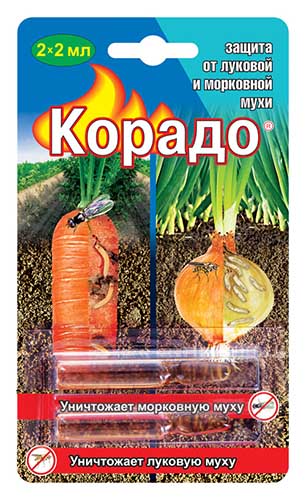
- Carrot fly;
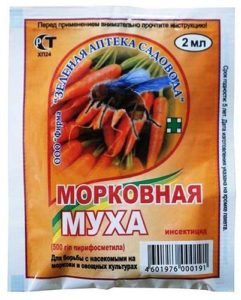
- Tsipi (Cypermethrin, an intestinal pyrethroid insecticide for protection against a wide range of gnawing and sucking pests);
- Caesar (Alpha-cypermethrin, a pyrethroid-class intestinal insecticide for protection against a wide range of gnawing and sucking pests);
- Shar Pei (Cypermethrin, a pyrethroid-class contact-intestinal insecticide for protection against a wide range of gnawing and sucking pests).

Folk remedies
If you don't want to use chemistry, then you can try folk remedies to protect carrots and fight carrot flies.
As a rule, infusions of fragrant herbs are used as a folk remedy for controlling carrot flies: they are watered over the plantings or simply laid out in the aisles.
It is worth understanding! It is impossible to "destroy" the flies with these green infusions, it is another matter that it is quite possible to scare off the flies with a pungent smell.
- Tomato tops. It can be made as a decoction (fill a bucket with tops, pour boiling water over it, let it brew for 2-3 days), or simply spread it between rows.
- Sagebrush.
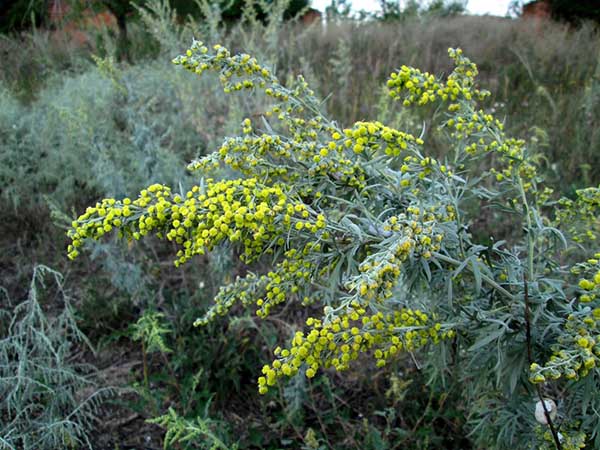
- Yarrow.
- Marigold.
- Calendula.
- Onion or garlic infusion, or spread their feathers (herbs) on the garden bed.

- Row spacing can be sprinkled wood ash or tobacco dust.
By the way! Wood ash Is not only a good insect repeller, but also an excellent potash dressing.
- You can still do dusting mustard, black or red spicy pepper.
Some gardeners advise using a solution to scare away carrot flies. ammonia... This is still a good nitrogen supplement.

- Vegetable oil and birch tar (see the video below for more details).
Video: scaring off the carrot fly without harming the environment
Thus, the preventive protection of carrots from carrot flies begins with proper planting and careful care.However, if the pest has nevertheless settled in your garden, then now you know how to deal with it and how you can handle it in order to scare it away or get rid of it completely.
Video: how to get rid of a carrot fly in the country

